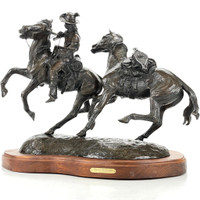Bronzes
Posted by MRC on Jan 16th 2025
Bronze is an alloy of copper and tin originally used for tools and weapons during the Bronze Age. The art of bronze sculptures dates back thousands of years. The earliest known bronze statue thought to have been created for artistic purposes is named “Dancing Girl”. Discovered in what is now Pakistan in 1926, this 4-inch-tall statue depicts a slender girl, nude, that dates back to at least 2500 BC. The lost wax casting method was used, which, at that time, consisted of sculpting the figure in wax, covering it in wet clay, and then heating it, simultaneously melting the wax and baking and hardening the clay. Molten bronze was poured into the resulting cavity. Once the bronze cooled, the clay was chipped away, revealing the statue.
The basic modern process for modern bronze sculptures, usually called simply “bronzes”, is as follows:
An artist sculpts a figure or image in clay. The resulting form is painted with rubber to create a mold. Once the rubber solidifies, it is coated with plaster, and clamped together. When the plaster has hardened, it is removed from the original clay. Now, there is a hollow shape of the artist’s creation. Hot wax is poured into the hollow mold to create a wax replica, which, when cooled, is worked on to clean up, make corrections, and add sprues. At times it is surgically dismantled to cast awkward pieces separately. Once the wax sufficiently resembles the original clay statue, it is dipped in investment. When the investment hardens, it is put in a kiln and molten bronze is poured into the investment mold. The wax disappears in what is known as “the lost wax process”, and the bronze perfectly takes its place, resulting in a hollow sculpture. The bronze piece, or pieces, are then welded together, filed, soldered and buffed, and the image, or form, is no longer in clay, but in bronze. Now for the finish: the patina. The bronze is heated and an acid wash is applied, creating the right “look” to compliment the artist’s vision. Sometimes, after that, acrylic paint is added to make certain details pop. The last step is a wax finish and final buff or shine. The result is a masterpiece that will endure for generations.
One of the cool things about this process, is that a number of bronze sculptures can be made from a single, original clay work. An artist usually determines ahead of time how many editions of a certain piece he will cast. Collectors can preorder, and some people like to select ahead of time which number they would like to purchase. For example: if I’m a collector, and an artist is coming out with a piece I would love to own, and he says it will be an edition of 20, I might select number 7 to buy because it’s my lucky number.
Foundries use a similar process to re-create classic works of art, crafted over 100 years ago by Western artists like Remington and Russell, making them accessible to modern collectors.
We have some of these works in our collection here.























